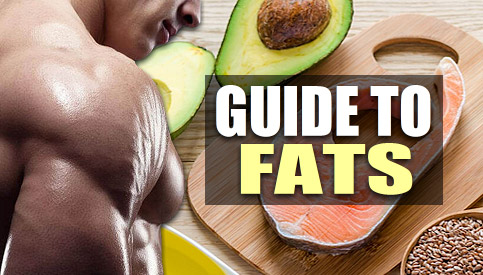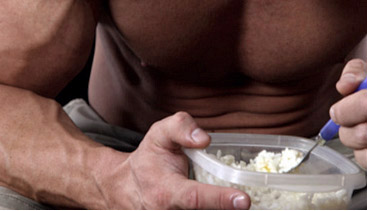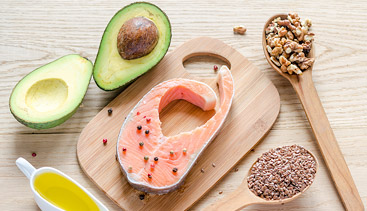BODYBUILDING AND FAT INTAKE: YOUR COMPLETE GUIDE

Back in the 60s and 70s, researchers claimed that dietary fat (particularly saturated fat) was responsible for a wide variety of health problems, including high cholesterol, heart disease, and obesity.
As it turned out, much of this was based on an incorrect interpretation of several flawed studies.
Things have now moved in the other direction.
With the rise of various nutritional approaches such as the ketogenic diet and other low carb variants, many people now consume very high intakes of fat as part of their bodybuilding and fitness plan.
But what’s the right approach here?
How much fat should you eat per day to build muscle, lose fat, and optimize your health. And from which sources?
In this post I’ll be giving a complete rundown on the topic of bodybuilding and fat intake to simplify the process and show you exactly how to go about it step by step.
Low Fat Diets Vs. High Fat Diets: Which Is Better?

Over the last few decades, extensive research has been conducted on low fat diets.
The results were not what most scientists expected.
Despite the traditional recommendations of a low fat intake for fat loss, muscle gain, and overall health, cutting fat consumption too low actually had the opposite effect.
Very low fat diets were found to elevate triglycerides while lowering the good cholesterol (HDL), which in turn increases the risk of heart disease. (1, 2)
People on excessively low fat diets also experience higher levels of hunger (making their diet harder to stick to), along with decreased mental well-being (greater anxiety and depression levels) than their higher fat counterparts. (3, 4)
Not only that, but going very low on fat can even be directly counterproductive to your muscle building and fat loss goals.
There is a direct connection between fat intake and muscle growth/fat loss, and here are just a few of the benefits associated with consuming sufficient dietary fat each day…
– Helps to keep testosterone levels within an optimal range. Testosterone is an absolutely critical hormone that regulates how much muscle mass you can build. (5, 6)
– Improves insulin sensitivity. This basically refers to the percentage of calories you consume that are stored in fat mass versus muscle tissue. (7)
– Increases activation of the mTOR pathway, a central trigger of protein synthesis. (8, 9)
– Reduces muscle catabolism by lowering activity of the “ubiquitin proteasome system” (a key pathway involved in muscle breakdown) and decreasing cortisol levels. (10, 11, 12)
– Decreases muscle soreness for better overall recovery and performance. (13, 14)
– Alleviates inflammatory joint pain for reduced injury risk and improved training longevity. (15)
Clearly, going too low on dietary fat is not a wise idea.
Dietary fat does not make you fat, and it actually plays a key role in optimizing muscle growth, fat loss and overall health.
What about going the opposite route by eating a very high fat diet?
Well, first off, it’s important to keep in mind that the benefits of fat listed above are subject to diminishing returns.
In other words, just because some dietary fat is good does not mean that more is better.
For example, many lifters mistakenly believe that since dietary fat increases testosterone levels, eating more and more fat will bump those levels continually higher.
But this is only true up to a point, and once your daily fat intake has hit a certain threshold, consuming greater amounts is not going to provide additional benefits.
And despite the fact that many individuals are able to lose fat and gain muscle successfully while following a high fat diet, this isn’t due to any special benefits associated with eating very large amounts of fat in and of itself.
The data has shown that consuming a higher percentage of calories from fat does not lead to greater net fat loss, and that very high fat eating plans such as a ketogenic diet do not produce any unique metabolic advantages. (16, 17, 18)
When it all comes down to it, losing body fat is primarily an issue of basic energy balance.
In other words, you must maintain a calorie deficit over time by burning more calories than you consume.
For some individuals, a higher protein/higher fat approach is more effective at achieving this simply because it helps them control their appetite more effectively.
As I’ve said many times before, the best fat loss diet is usually whatever type of eating structure allows you to most easily maintain a calorie deficit over time in terms of meal frequency, meal timing and macronutrient breakdown.
If a high fat approach helps you accomplish that, then it may be a viable diet to experiment with.
However, this is a highly individual thing, and for many others (and in fact I’d say most others), very high fat diets that heavily restrict carbohydrates are generally not sustainable and lead to poorer long term outcomes.
Let’s also not forget that dietary fats contain 9 calories per gram, which is more than double the 4 calories per gram that protein and carbs contain.
Net calorie balance ultimately dictates whether you gain or lose weight, and by going higher in fat, you’ll have fewer calories left over for protein and carbs.
Fat Intake For Bodybuilding: How Much Fat Should You Eat Per Day?

We’ve established that very low fat diets are directly counterproductive to your health and fitness goals, and that very high fat diets, while not necessarily counterproductive, do not produce any special advantages for muscle gain or fat loss.
For most people in most situations, neither under-consuming nor over-consuming fat will likely be the ideal approach.
“Extreme” diets that go very high on certain macronutrients while restricting others are usually not sustainable for the vast majority of people, and as with most things, a healthy middle ground approach is usually best.
So, what is an effective and sustainable fat intake for muscle gain, fat loss and overall health?
For the average lifter out there, deriving about 25% of your total daily calories from fat will be a good figure to aim for.
Going a bit higher is fine if you prefer, but I wouldn’t suggest going any lower than 20% as a minimum.
The precise gram amount doesn’t need to be exact here (this is just an approximate figure), and landing somewhere roughly around this amount will work fine for most people.
It will provide you with all of the benefits of fat while still leaving plenty of room for sufficient protein and carbohydrate intake.
To calculate your daily fat intake, just take your total daily calorie intake and multiply it by 0.25 (this will give you the total number of calories to consume from fat) and then divide it by 9 (since fats contain 9 calories per gram) to get the actual gram amount.
For example, let’s say your daily calorie intake was 2700.
First you’d multiply this by 0.25, giving you 675 daily calories in the form of fat. From there, divide 675 by 9, giving you 75 grams of fat per day to consume.
What Are The Best Sources Of Fat To Eat?

We’ve now covered the specific benefits of fat and have established a healthy and effective daily fat intake for muscle gain, fat loss, and overall health you can follow.
A discussion about bodybuilding and fat intake wouldn’t be complete without also breaking down the four main types of fat found in your diet…
Monounsaturated Fat (MUFAs)
Monounsaturated fatty acids are most well-known for their cardiovascular benefits.
They can be derived in high concentrations in plant oils such as olive oil, avocado oil, hazelnut oil, macadamia nut oil, safflower oil, almond oil, as well as in avocados, peanut butter, and many nuts and seeds.
It’s believed that at least part of the health benefit of Mediterranean diets is due to the large intake of olive oil, which provides oleic acid (the primary monounsaturated fat) and is associated with a variety of positive health effects.
Saturated Fat (SFAs)
Saturated fats are often given the blame for a wide variety of health problems, with some people recommending that their intake be minimized as much as possible.
On the other hand are those who take the opposite approach by claiming that saturated fat is completely harmless and can be consumed in whatever amount an individual pleases.
As with most questions related to proper nutrition, the best answer tends to lie somewhere in the middle.
Without going into too much detail, the term “saturated fat” actually refers to a variety of fatty acids (palmitic acid, lauric acid, stearic acid etc.) each of which have differing effects in the body, some potentially more negative or positive than others.
So, using the blanket term “saturated fat” is not entirely accurate in the first place.
In addition, the specific effects that these fatty acids exert depends at least in part on the relative health and fitness of the individual.
Those who are lean, active and eating a nutrient-dense diet don’t seem to respond negatively to higher saturated fat intakes, while those who are overweight and follow a generally unhealthy lifestyle see much more pronounced effects on things like blood lipids and cholesterol levels.
Saturated fat is also necessary for optimal testosterone production, so trying to completely limit it is not going to be a wise idea.
Examples of foods higher in saturated fats are animal meats, egg yolks, dairy products, and coconut.
The bottom line though is that saturated fat is neither “good” nor “bad,” and as long as you’re training consistently and eating a reasonably nutrient rich diet, it probably isn’t something you need to specifically worry about.
You’ll usually obtain enough automatically from animal products and from the small amounts of tag along saturated fat in other food sources in your diet.
Polyunsaturated Fatty Acids (PUFAs)
Unlike monounsaturated fats and saturated fats (which are technically not needed for basic survival), polyunsaturated fats are “essential fats” that must be consumed in adequate amounts from your diet in order to prevent deficiency and serious health consequences.
The two main types of polyunsaturated fats are the omega-3 and omega-6 fatty acids.
The optimal ratio between omega-3 to omega-6 intake is somewhere between 1:1 and 1:4. This is the ratio that humans ate throughout most of our evolution.
However, modern diets have skewed this ratio significantly, with the average consumption now landing somewhere between 1:15 – 1:17 in favor of omega-6’s. (19)
This is due to the much higher omega-6 content found in the current food supply as well as the lack of omega-3’s that most people consume.
Excessive intakes of omega-6 fatty acids have been associated with increased levels of inflammation and are often pointed at as a cause of many modern diseases, though the research in this area is still mixed and inconclusive.
One thing is for certain though, and that is that increasing the consumption of omega-3’s almost always leads to better health outcomes in a virtually endless list of different areas.
This includes improving cardiovascular health, lowering blood triglycerides, reducing blood pressure, boosting the immune system and improving mental health, among many other things.
A study by The Harvard School Of Public Health found that omega-3 deficient diets are the sixth highest killer of Americans, causing up to 96,000 preventable deaths every single year. (20)
So, if there’s one thing to take away from this section regarding the various types of fat, it’s that you should probably make a concerted effort to get more omega-3’s into your diet.
Specifically, it seems that the omega-3 fatty acids EPA (eicosapentaenoic acid) and DHA (docosahexaenoic acid) are the ones of particular benefit.
Unfortunately, the average Western diet provides just 10-20% of the proper amount per day. (21)
The American Heart Health Association recommends 1 gram of combined EPA/DHA daily (though research has shown benefits up to 6 grams daily), with the average Westerner taking in just 0.1-0.2 grams daily. (22)
The best way to ensure adequate consumption of EPA and DHA is by consuming a few servings of fatty fish per week (salmon, mackerel, sardines etc.) or by supplementing with a high quality fish oil.
Certain plant based sources such as flaxseeds and nuts do contain a good dose of omega-3’s as well, however, these provide ALA (alpha-linolenic acid) which has a very poor downstream conversion into EPA and DHA.
Trans Fats
Last on the list are trans fats.
These are created when vegetable oils undergo a process called hydrogenation (hydrogen is bubbled through the oil) in order to partly solidify it and increase its shelf life.
This works out great for food manufacturers, but not so great for consumers.
When vegetable oils are hydrogenated, their chemical structure is changed into a form that the body is not properly equipped to deal with.
Excessive trans fat consumption can lead to a wide variety of health problems, including inflammation, heart disease, depression, insulin resistance, and increased body fat.
To quote a meta analysis on the negative health effects of trans fats:
“TFA [trans-fatty acid] consumption causes metabolic dysfunction: it adversely affects circulating lipid levels, triggers systemic inflammation, induces endothelial dysfunction, and, according to some studies, increases visceral adiposity, body weight, and insulin resistance…Consistent with these adverse physiological effects, consumption of even small amounts of TFAs (2% of total energy intake) is consistently associated with a markedly increased incidence of coronary heart disease.” (23)
Foods high in trans fat include processed baked foods like cakes, pies, cookies, donuts and muffins, margarine, fried fast foods, frozen pizzas and microwaved meals.
Although many of these items will be listed as 0 grams of trans fat on the nutrition label, keep in mind that any item containing less than 0.5 grams can technically be labeled as trans fat free.
There isn’t really much debate on the issue here – trans fats have no benefits at all to humans and are purely negative from a health standpoint.
I’m not saying that “treat foods” such as those listed above must be totally avoided, but just be aware that foods containing higher concentrations of trans fat should be kept under limits if optimizing overall health is important to you.
The American Heart Association recommends no more than an average of 2 grams of trans fat per day.
Fat Intake For Bodybuilding: Quick Review

Dietary fat plays many important roles in the body related to building muscle, burning fat and maintaining optimal overall health.
Very low fat diets (less than 15-20% of total calories) can actually be detrimental to your health and fitness, and while very high fat diets (such as ketogenic diets) can be used successfully if they result in better appetite control, they don’t possess any special fat loss benefits and are usually not sustainable in the long run.
As a general rule of thumb, a middle ground of about 25% of total calories will be a reliable fat intake for fat loss and muscle gain that strikes a good balance for most lifters.
In terms of the various different types of fat, most people already consume adequate monounsaturated fat, saturated fat and omega-6’s as long as they’re eating a reasonably balanced diet.
However, the one area you should pay attention to is your intake of omega-3’s, specifically the fatty acids EPA and DHA.
These are associated with significant improvements in health, and most people consume far less than the recommended amount of 1 gram or more per day.
Consuming fatty fish or supplementing with fish oil is the most reliable way to increase your EPA/DHA levels.
Check out these fat loss myths so you don’t fall prey to the B.S.
Found these tips about bodybuilding and fat intake helpful? Make sure to get your personalized training, nutrition and supplement plans using my free interactive video presentation below…
If you found this article helpful, make sure to sign up for your FREE custom fitness plan below...




